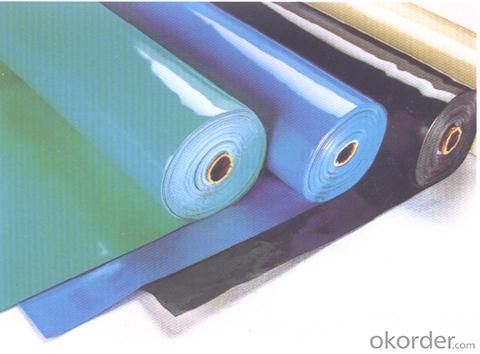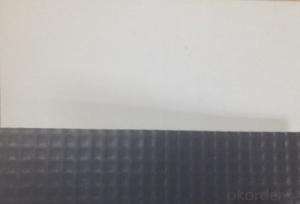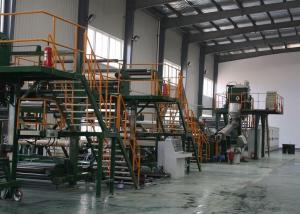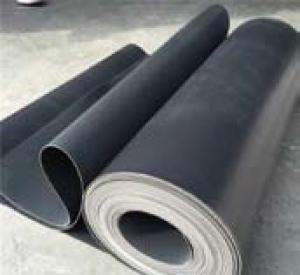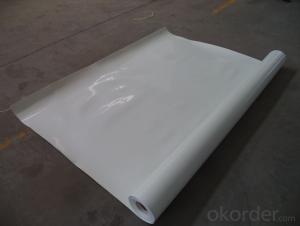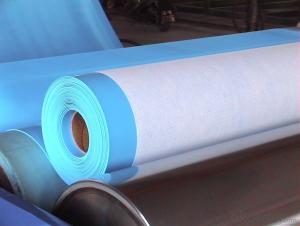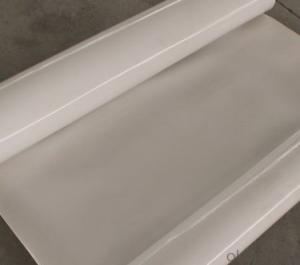TPO Waterproof Membranes
- Loading Port:
- China Main Port
- Payment Terms:
- TT OR LC
- Min Order Qty:
- -
- Supply Capability:
- -
OKorder Service Pledge
OKorder Financial Service
You Might Also Like
PVC Waterproof Membrane
TPO Waterproof Membrane
Products Description
The Thermoplastice Polyolefin (TPO) waterproof membranes are the most
popular waterproof materials in the world at present. It’s thermoplastic elastomeric
waterproof materials by adopting advanced polymerization together with squeeze
technology,which perform well in mechanical properties, high tensile strength,
oxidation-resistance and resistance to puncture.
Products Specification
Divided by product categories:
1.non-homogeneous composite membrane (code H)
2.with fiber composite backing sheet (code L)
3.fabric reinforced sheet (code P)

Products Hall
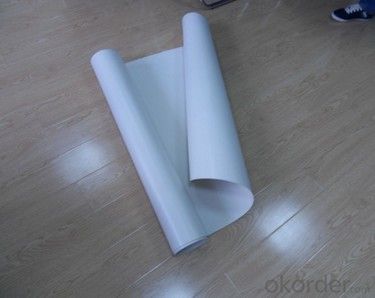
Physical Properties
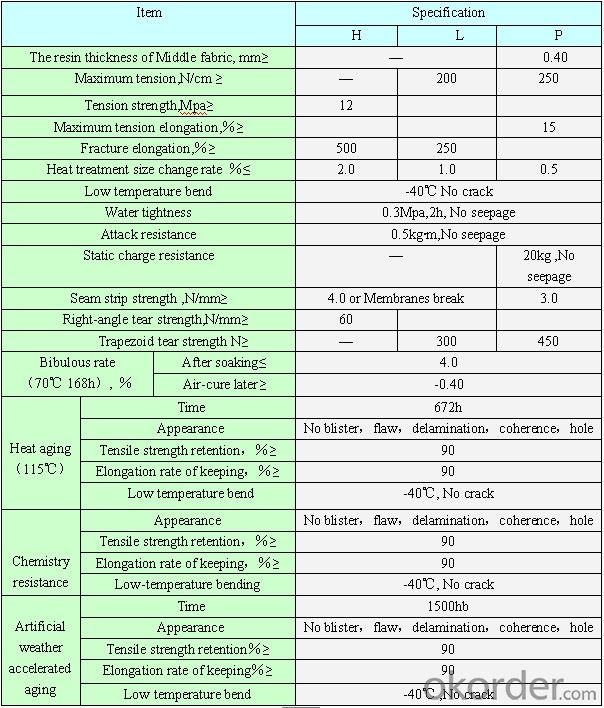
Application Range
Widely applied on various kinds of waterproofing projects:
1. Subways and tunnels
2. Roofs of sports complex
3. Green roofs
4. Exposed roofs
5. Steel roofs
6. Waste land filling yards
Wildly be used in roofing waterproof
- Q: Is a waterproofing membrane resistant to cracking or shrinking?
- Yes, a waterproofing membrane is designed to be resistant to cracking and shrinking, providing a durable and long-lasting solution for preventing water penetration.
- Q: Can a waterproofing membrane be used for a roof deck?
- Certainly! A roof deck can indeed utilize a waterproofing membrane. Its purpose is to safeguard against water infiltration, rendering it a perfect resolution for roof decks that face rain, snow, and other atmospheric conditions. Typically, the membrane is administered atop the roof deck surface, constructing an impermeable and long-lasting barrier that thwarts water from permeating the underlying structure. Consequently, this elongates the lifespan of the roof deck while shielding it from possible water harm. Furthermore, certain waterproofing membranes present supplementary advantages, including UV resistance and thermal insulation, thereby amplifying their appropriateness for roof deck usage.
- Q: Can a waterproofing membrane be used for elevator shafts or equipment rooms?
- Elevator shafts and equipment rooms, being frequently exposed to moisture and water infiltration, can suffer significant damage to their equipment and structural components. Consequently, it becomes essential to implement a dependable waterproofing solution in order to prevent water penetration. One commonly employed method for safeguarding elevator shafts and equipment rooms against water damage is the use of a waterproofing membrane. This membrane, a thin layer of material, is applied to the surfaces of the shaft or room and functions as a barrier against water intrusion. Various materials like bitumen, PVC, or EPDM are typically utilized for these membranes due to their excellent waterproofing properties. To create a seamless and watertight enclosure, the waterproofing membrane is applied to all exposed surfaces, including walls, floors, and ceilings. Its purpose is to withstand hydrostatic pressure and prevent water from seeping into the elevator shaft or equipment room. Additionally, the membrane can also provide protection against other forms of moisture, such as condensation. Moreover, to enhance the effectiveness of the waterproofing membranes, they can be combined with other techniques like sealants and drainage systems. This multi-layered approach ensures a comprehensive waterproofing solution for elevator shafts and equipment rooms. In conclusion, a waterproofing membrane proves to be a suitable and reliable solution for protecting elevator shafts and equipment rooms from water infiltration. Its application creates a watertight enclosure, preventing potential damage to the equipment and structural components in these areas.
- Q: Can a waterproofing membrane be used on elevator shafts?
- Yes, a waterproofing membrane can be used on elevator shafts. Elevator shafts are vulnerable to water infiltration, and using a waterproofing membrane can help prevent water damage and leakage into the shaft.
- Q: Can waterproofing membranes be applied on roofs?
- Yes, waterproofing membranes can be applied on roofs. These membranes are specifically designed to provide a protective layer against water infiltration and are commonly used in the construction industry to waterproof various types of roofs, including flat roofs, pitched roofs, and sloped roofs.
- Q: What are the requirements for frost resistance of basement floor polymer waterproofing membranes?
- Requirements are, when the material quality testing, the ground temperature must meet the requirements of national norms.
- Q: Are waterproofing membranes suitable for high-traffic areas?
- Waterproofing membranes prove to be an ideal solution for areas with high foot traffic. Their purpose is to create a barrier against water infiltration, safeguarding the structure and preventing water-related harm. It is worth noting that high-traffic zones like walkways, driveways, parking lots, and other heavily frequented spaces are at risk of continuous exposure to water, resulting in structural damage and gradual deterioration. By employing waterproofing membranes in these areas, water penetration is effectively thwarted, guaranteeing their resilience and longevity. Furthermore, these membranes are often engineered to be slip-resistant, adding an extra layer of safety in high-traffic zones. Consequently, implementing waterproofing membranes in such areas is a prudent decision to address water-related concerns, preserve the structural integrity of the space, and ensure the safety of its occupants.
- Q: Is a waterproofing membrane resistant to UV radiation?
- Typically, a waterproofing membrane is resistant to UV radiation. Most manufacturers design these membranes to be durable and long-lasting, ensuring they can withstand exposure to UV rays. Over time, UV radiation from the sun can cause degradation and damage to various materials, including waterproofing membranes. To combat this, manufacturers often include UV stabilizers and additives in the membrane's composition. These additives prevent the breakdown of the membrane's structure, allowing it to remain effective in preventing water infiltration and maintaining its performance for an extended period, even when exposed to direct sunlight. Some waterproofing membranes may also have a protective layer or coating that offers extra UV resistance. To understand the specific UV resistance capabilities of a particular waterproofing membrane, it is advisable to consult the manufacturer's specifications and guidelines.
- Q: Can a waterproofing membrane be used for tunnels and underground structures?
- Tunnels and underground structures necessitate the use of a waterproofing membrane to combat water infiltration and safeguard against potential water damage. Such membranes are commonly employed in construction to create a barrier against water and are particularly vital in these situations due to the increased risk of water ingress from surrounding soil and groundwater. The integrity and longevity of the infrastructure rely on waterproofing membranes in these environments. Waterproofing membranes designed for tunnels and underground structures are specifically engineered to endure the unique challenges presented by these settings. Typically composed of resilient and flexible materials like bitumen, PVC, or EPDM, they effectively resist water pressure and provide long-lasting protection. Furthermore, these membranes are often reinforced with multiple layers or fabrics to enhance strength and resistance against punctures or tears. The meticulous process of applying waterproofing membranes in tunnels and underground structures involves thorough cleaning and preparation of surfaces such as walls and floors to ensure proper adhesion of the membrane. Multiple layers are then applied to achieve complete coverage and a seamless seal. Special attention is paid to critical areas such as joints, corners, and penetrations to eliminate potential weak points. The utilization of a waterproofing membrane effectively shields tunnels and underground structures from water intrusion, groundwater pressure, and potential moisture-induced damage. This preserves the structural integrity of the infrastructure, prevents water-related issues like leaks, corrosion, or deterioration, and guarantees the safety and functionality of the tunnel or underground facility.
- Q: Are waterproofing membranes resistant to alkalis?
- Yes, waterproofing membranes are generally resistant to alkalis. Alkalis are substances with a high pH level, such as sodium hydroxide or potassium hydroxide, and can be found in various construction materials, including concrete. Waterproofing membranes are specifically designed to provide a protective barrier against water and other potentially damaging substances. They are typically made from materials such as modified bitumen, PVC, or EPDM, which have excellent resistance to alkalis. This resistance ensures that the waterproofing membrane remains intact and effective, even when exposed to alkaline substances. It is important to choose a waterproofing membrane that is specifically designed for alkali resistance when working with materials or environments that contain high levels of alkalis.
Send your message to us
TPO Waterproof Membranes
- Loading Port:
- China Main Port
- Payment Terms:
- TT OR LC
- Min Order Qty:
- -
- Supply Capability:
- -
OKorder Service Pledge
OKorder Financial Service
Similar products
Hot products
Hot Searches
Related keywords



